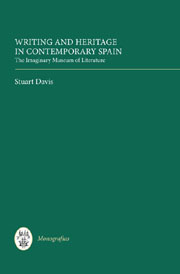Book contents
- Frontmatter
- Contents
- Acknowledgements
- Introduction
- 1 Presenting the Museum
- 2 Never-ending Story: Canon Fever
- 3 Working Models, Model (Re)Workings: Goytisolo and Cervantes
- 4 The Authoritative Gaze: Cristina Peri Rossi
- 5 Generations Apart? The ‘Generation X’ in Spanish Literature
- Conclusion: What do we do with the Gifts of the Past?
- Works Cited
- Index
2 - Never-ending Story: Canon Fever
Published online by Cambridge University Press: 05 February 2013
- Frontmatter
- Contents
- Acknowledgements
- Introduction
- 1 Presenting the Museum
- 2 Never-ending Story: Canon Fever
- 3 Working Models, Model (Re)Workings: Goytisolo and Cervantes
- 4 The Authoritative Gaze: Cristina Peri Rossi
- 5 Generations Apart? The ‘Generation X’ in Spanish Literature
- Conclusion: What do we do with the Gifts of the Past?
- Works Cited
- Index
Summary
Lo que intento hacer es defender el canon tradicional de la literatura occidental. Me interesa seguir demostrando por qué Shakespeare, Cervantes, Dante, Milton, Dickens y otros muchos son los autores que la gente debe leer.
Harold Bloomlo que entendemos por ‘literatura’ es, en fin, la ‘historia de la literatura’. José Carlos Mainer
Visit: Museo de la Biblioteca Nacional de España
Like many grand national museums, the Biblioteca Nacional de España (BNE) has an imposing presence just a stone's throw from one of the main thoroughfares of Madrid's city centre, the Paseo de Recoletos. From the street, the eye is drawn above the railings to the building's frieze, populated with muses, deities, human allegories of arts, war and peace; above the frieze atop the building sits Spain herself, a laurel wreath held aloft in her hand, and above her flies the national flag. The façade is supported by eight neo-classical columns, standing above a trio of door arches, themselves reached by ascending several dozen steps. The architect of this building, Francisco Jareño, designed the edifice in the 1860s in the same neo-classical vein as the Prado art gallery and other European institutions such as Berlin's Altes Museum, in the grand nineteenth-century museum tradition. If the building itself were not imposing enough, whilst ascending the steps the visitor passes the striking marble statues of several literary giants of Iberian history: firstly St Isidro and Alfonso X, as founders of the Castilian language's primary role in literary and historical writing; later, guarding the doors, Antonio de Nebrija, Luis Vives, Lope de Vega and Cervantes as four of the most prominent writers and thinkers from the fifteenth century to the seventeenth.
- Type
- Chapter
- Information
- Writing and Heritage in Contemporary SpainThe Imaginary Museum of Literature, pp. 48 - 73Publisher: Boydell & BrewerPrint publication year: 2012



